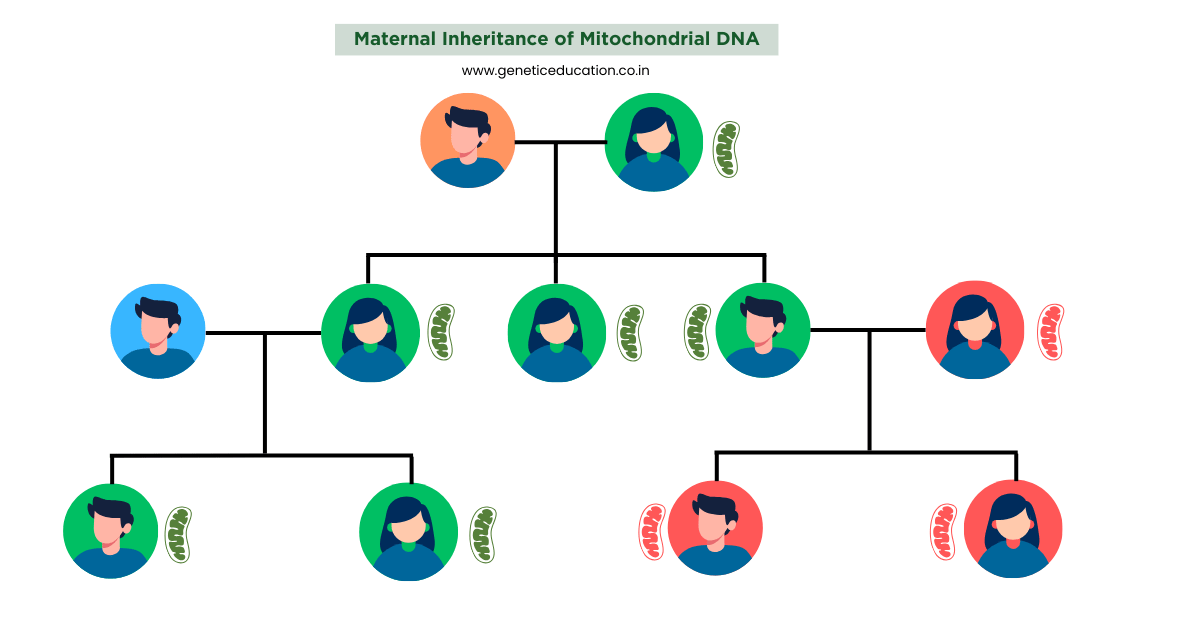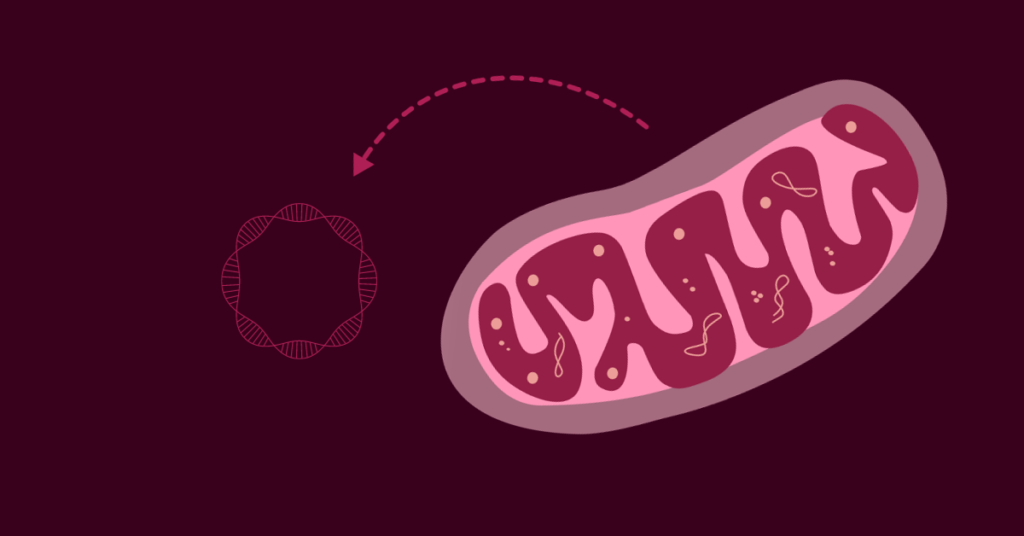“Understand the concept of maternal inheritance in mitochondrial DNA. Gain insight into the 8 possible mechanisms explaining why the mtDNA is inherited maternally.”
Mitochondrial DNA is extranuclear, cytoplasmic and organelle DNA present in a cell. Genes present here participate in energy production and distribution. Mutations in mtDNA also produce health-related issues and affect overall well-being.
The subject of maternal inheritance of mitochondrial DNA is a prominent and extensively discussed topic within the scientific community. In contrast to nuclear inheritance, it possesses a unique characteristic—being inherited uniparentally and consistently from the maternal lineage.
Mitochondrial DNA inheritance occurs uniparentally in various organisms, primarily through maternal lineage; however, instances of paternal inheritance are also documented across various species.
In humans, the mitochondrial DNA is consistently inherited from the maternal side. But the burning question remained unanswered! Still, why is the mitochondrial DNA inherited maternally?
I did a literature review, and trust me! It was a difficult task to extract the exact reason(s) why this is so! Literature majorly explains the mechanisms using which it is inherited.
After extensive research on the topic, I have formulated potential explanations for the maternal inheritance of mitochondrial DNA.
Stay tuned.
Related article: Mitochondrial DNA vs Nuclear DNA- Differences and Similarities.
Disclaimer: The content presented herein has been compiled from reputable, peer-reviewed sources and is presented in an easy-to-understand manner for better comprehension. A comprehensive list of sources is provided after the article for reference.
Key Topics:
8 Reasons Why Mitochondrial DNA Is Inherited Maternally

Start with the Beginning!
Sperm and egg cells fuse to form an embryo. And a healthy life form later on! Sperm and egg cells are contributed by male and female participants, respectively. With the cell fusion, the singular nuclear genome from both sides also prepares a duplex genetic framework for the fetus.
Mitochondrial DNA is only contributed by the female participant. Here are the reasons why.
Related article: Difference Between Y DNA vs Mitochondrial DNA Test.
Copy number and bottleneck effect
Sperm and egg cell copy numbers vary substantially. A typical spermatozoon contains 50 to 75 mtDNA per cell while a typical oocyte contains 1,00,000 to 4,00,000 mtDNA per cell. Higher mDNA participates in more energy production. Thus maternal mitochondrial DNA copies are inherited.
Meanwhile, the sperm mitochondria face the bottleneck effect. The majority of DNA present near the sperm tail can not enter the oocyte, as the tail can’t penetrate in oocyte. So due to the bottleneck effect only a small number of sperm DNA enters the oocyte.
Higher energy requirement
A huge amount of energy is required for the fusion of oocyte and spermatozoon, thus more energy as ATP and so more mitochondria are required. Paternal mitochondria, as mentioned in the above point, face the bottleneck effect and can’t contribute a sufficient amount of mitochondria.
Contrary, the oocyte has a large number of mitochondria and can compensate for energy requirements. The present argument also favors the maternal inheritance of the mtDNA.
Now, you may have a question, can both contribute their mitochondria? No. Let me explain in the next point.
Cellular defense system
Now, there are two aspects of this mechanism. First, a cell’s defense mechanism resists the existence of any foreign particles. In this case, it’s mitochondrial DNA from the sperm cell. So by natural means, actions such as endocytic and autophagic activities lead to sperm mitochondrial degradation.
This also leads to the degradation of most of the sperm DNA in the oocyte. Contrary, the oocyte’s own mitochondrial DNA is known to the cell and safe to use. So the oocyte chooses its mitochondrial DNA and not the ‘foreign’ sperm DNA.
Genetic compatibility
Another point also favors the present discussion which is the genetic compatibility between the nuclear DNA and mitochondrial DNA. The unique property of the mitochondria is the presence of genetic material.
However, to produce energy and perform important activities like oxidative phosphorylation, it has to work in collaboration with nuclear DNA (or genes). Oocyte’s mtDNA is known to cells and both have developed a collaborative fine-tuning for performing various functions for mitochondria.
Contrary, the sperm cell mtDNA isn’t known for the host cell, it may contain harmful mutant or defective alleles that can potentially disrupt the host cell activities. In this sense, it is not compatible with the host’s nuclear DNA.
Therefore, the oocyte strategically avoids conflict between the nuclear and mitochondrial DNA and always selects the maternally originated mtDNA over the sperm mtDNA.
Conflict between maternal and paternal mtDNA
There are high chance that the presence of both maternal and paternal mitochondrial DNA, like the nuclear DNA, compete with each other, and produce conflict.
So, during the emergency energy requirement (for example, embryo formation), a cell has to invest more energy in resolving the conflict. Resultantly, it disrupts a cell’s fine-tuning and balance for cellular activities.
On the safer side, the cell chooses maternal mtDNA over the paternal one.
Low mutant copy numbers
A higher copy number reduces the chances of inheriting deleterious and pathogenic mutations. Research showed that the higher maternal mitochondrial copy numbers are associated with a lower prevalence of the mutant alleles.
In addition, such mutations can be repaired during replication as well. So overall, the chances that the maternal mitochondrial DNA would inherit any faulty DNA are less. That’s known to the host cell. (how smart the cellular mechanism is!)
On the other hand, low copy number sperm DNA has a higher chance of acquiring mutant alleles that can be inherited and produce genetic instability between nuclear and mtDNA.
This is another crucial factor for why maternal mitochondrial DNA and why not paternal mitochondrial DNA, is inherited.
Selectively efficient and consistent
Cell adopts the best option for itself! Mitochondrial Maternal inheritance is the most efficient and consistent mechanism throughout evolution. During fertilization, the host cell knows that this is the best and trusted option for the process.
So using as many ways as possible, it tries to avoid or prevent the sperm mitochondrial DNA from participating in any activities during this process. Eventually, the overall situation becomes safer for the growing embryo.
Lacking several genes
Recent studies also demonstrated that the sperm mitochondrial genome also lacks some important genes which are not required for the sperm cell, For example, a gene for TFAM- A transcriptional factor associated with mitochondria is not present in the paternal mitochondrial DNA.
The present gene plays a significantly important role in producing a protein needed for accurate transcription of mitochondrial DNA. The TFAM gene is present in the maternal mitochondrial genome. And thus, benefits in selection.
Related article: Extrachromosomal Inheritance- Definition, Criteria, Maternal Inheritance and Examples.
Wrapping up
Uniparental inheritance holds significance alongside biparental inheritance in nature, showcasing benefits in specific contexts. The maternal inheritance of mitochondrial DNA serves as a beneficial example, highlighting the remarkable advantages of uniparental inheritance.
The picture is now clear, certainly. The maternal mitochondrial DNA is superior to the paternal or spermatozoon mitochondrial DNA. Therefore, the oocyte has to destroy it anyway.
I hope you like this article. Please share it with your friends and bookmark the page.
Sources:
Wallace, Douglas C. “Why do we still have a maternally inherited mitochondrial DNA? Insights from evolutionary medicine.” Annual review of biochemistry vol. 76 (2007): 781-821. doi:10.1146/annurev.biochem.76.081205.150955.
Chan DC, Schon EA. Eliminating mitochondrial DNA from sperm. Dev Cell. 2012 Mar 13;22(3):469-70. doi: 10.1016/j.devcel.2012.02.008. PMID: 22421036; PMCID: PMC3995028.


